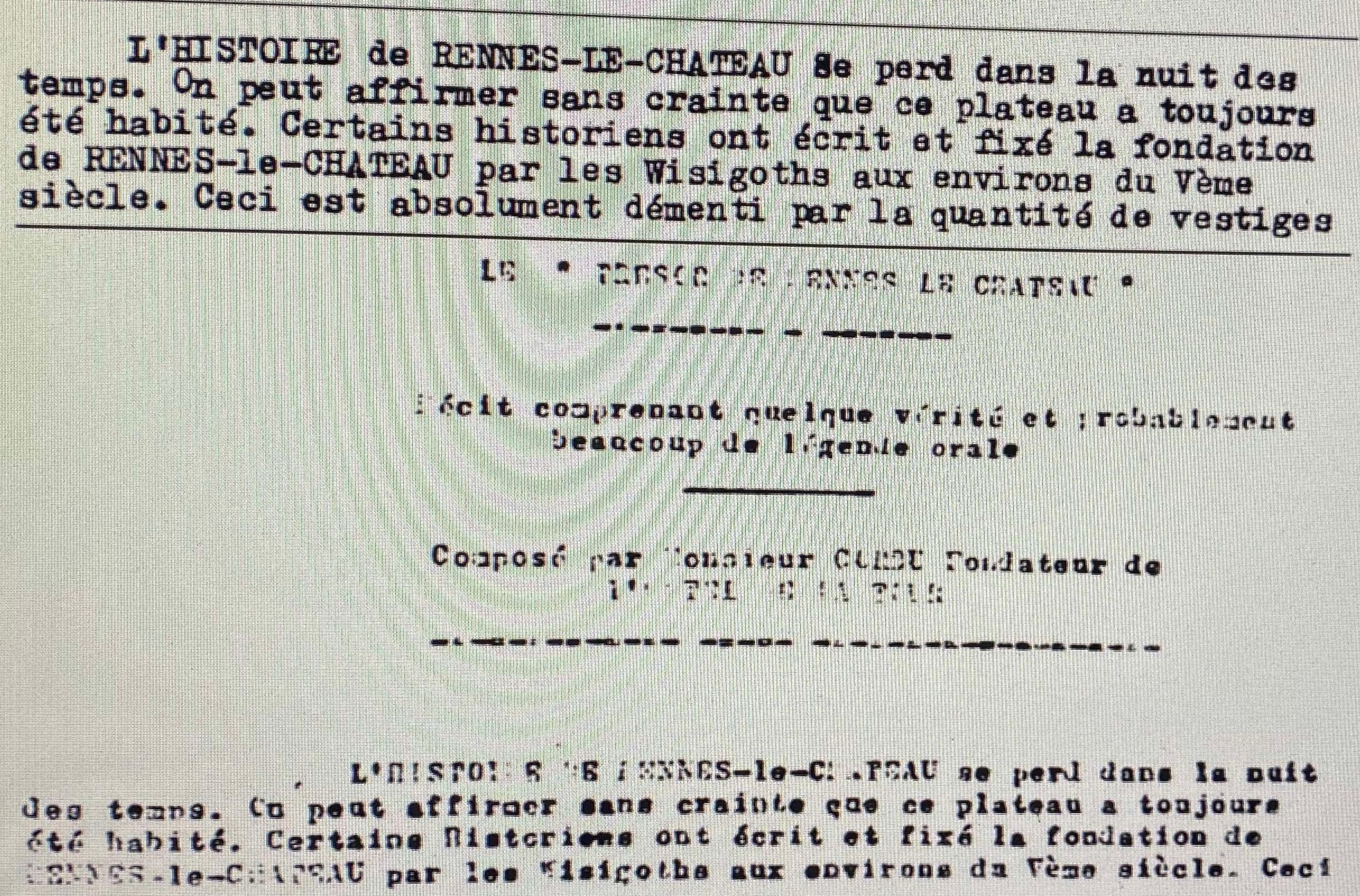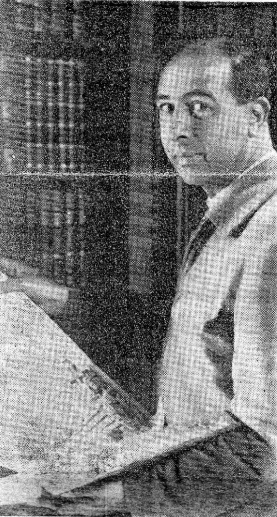Another clarification...
Paul Smith wrote;
"René Descadeillas both massacred and slaughtered the myths of the parchments and Saunière going to Paris, and Poussin.
The trouble is that people like Sandy Hamblett seriously believe in “Notice sur Rennes-le-Château et l’Abbé Saunière” (1962) that was written when Descadeillas was still a believer, and they naturally keep silent about his later book “Mythologie du Trésor de Rennes” (1974) – written when Descadeillas became a skeptic and no longer believed in the things that were outlined in his earlier 1962 book.
When Descadeillas published his “Mythologie du Trésor de Rennes” – he placed an “interdit” on his earlier 1962 work being copied because he changed his mind and his earlier work no longer represented his views. It was forbidden to photocopy his 1962 book. It does not matter anyway because nobody takes any notice of the myths.
It was only after the death of Descadeillas in 1986 and when the “interdit” on his earlier book had expired – that Michel Vallet published the 1962 book by Descadeillas because Michel Vallet is a true believer in the treasure of Rennes-le-Château".
I would just like to clarify that the quotes I used about the parchments from Descadeillas in my last post ARE NOT FROM his Notice, but from his Mythologie du Trésor de Rennes. You know Paul? The book you champion about the truth of the Affair of the Two Rennes!
And regarding the following Smith assertions:
"There is no evidence that “Power and Death” was written by Noël Corbu for several reasons. A certain name keeps cropping-up as the real author of that text (not Pierre Plantard or Philippe de Chérisey)".
And;
"If this text was indeed written by Corbu [ i.e Power & Death], then why was it not deposited in the Archives de l’Aude ?!!"
I would like to say I believe it was. But under a different title - Putnam and Wood [another favourite set of authors for Smith] also reported it in their book The Treasure of Rennes-le-Chateau - as follows;
"The Archives at Carcassonne -
The Departmental Archives at Carcassonne include documents of all kinds, secula and ecclesiastical, minutes of meetings of the municipal and parish councils, ol newspapers and many others. Some papers have been deposited there by their authors as a permanent record of their work. In this chapter we are examining two documents, both by individuals. The first one has the title L'histoire de Rennes-le-Château (The History of Rennes-le-Château). It was placed in the archives on 14 June 1962 (a year after the film made for television) by a Maurice Tous of Alet-les-Bains. Oddly this document does not bear the author's name, but there is no doubt that it was written by Noël Corbu. Firstly the document was actually typed on the same typewriter as Corbu used for his own personal correspondence. Secondly, there is a curious spelling mistake: Saunière is spelled with a final 's', and amazingly that is the way Corbu typed the curé's name. Also, at some time the text of this 'History of Rennes-le-Château' was retyped on another machine, and displayed in the Museum at Rennes-le-Château with a remark to the effect that this was what Corbu told his visitors to the Hôtel de la Tour". [p.19].
There are several discussions on line among French researchers about 'Power and Death' viz;
"The dating of the text is controversial. Claire Corbu and Antoine Captier claim it to be the transcription of a tape recording datable to the years 1955-56 (Corbu & Captier, L'héritage de l'Abbé Saunière, Nice: Bélisane, 1995, p.60). Patrick Mensior (in "Quand l'escriture D.M. trouvée !", Parie moi de Rennes-leChàteau 1 (2004), p.99) adds that it was Maurice Tous of Alet-les-Bains, a customer of the restaurant La Tour, who transcribed it and deposited it with the Departmental Archives of the Aude on 14 June 1962 (n.4407, with lease 89 W 106; towards 1978 the document was moved to section 2J where today it can be consulted at n.248). Mensior's note corrects the "classic" dating of 1965, proposed by Pierre Jarnac in his monumental "Bibliographie de Rennes-le-Chàteau" in Les Cahiers de Rennes-leChàteau 12, Belisane, 2002, pp.12-13. The text however should date back to the years between 1961 and 1962, since the tape/recorder [where the story/ text was played to restauranteurs at Corbu's hotel] was given to Noèl Corbu in 1961 by the brother of Jean Raffy (famous French painter known as Raffy-le-Persan): who was a regular customer of Corbu; he had fallen into poverty & was forced to pay for his stay in Rennes-le-Chàteau with some of his personal possessions, including the tape-recorder then used to record th text for La Tour restaurant customers to listen to (Patrick Mensior, http://www.renneslechateau.com/forums/ viewtopic.php? P=37920#37920). The written transcriptions of this text actually number two copies: one (Corbu A) is does not have the title and subtitle shown below (which was present only in Corbu B, the second version - see Pierre Jarnac, Les Archives du Trésor de Rennes-le-Chàteau, Nice: Bélisane, 1987/1988, pp.485); another minimal difference is indicated in the course of the text by a translator's note.

Noel Corbu (1912-1968) inherited the domaine of Bérenger Saunière and made it a restaurant; to tell the old parish priest's story to his clients, Corbu recorded a tape in which historical facts were mixed with local legends and his personal hypotheses. It is assumed that this transcription (Corbu A) faithfully reproduces the original text recorded by the hotelier: this is what his daughter says, reporting the text in C.Corbu and A.Captier, op.cit., pp.55-60.
As with the more famous Le trésor de Rennes-le-Chàteau, the dating of this text is also controversial. According to Claire Corbu, between 1964 and 1965 her father Noél was writing in a notebook a book that he intended to publish on Rennes-le-Chàteau. Following the sale of the domain to Henri Buthion in 1965, Corbu abandoned the village and also the project; in the following years the notebook disappeared along with much other documentary material, perhaps due to theft.
Some time later, a document written on the same typewriter as Corbu, entitled La Puissance et la Mort, was found. Its origin, together with some intertextual elements, led Patrick Mensior to assume that it is a text by Noél Corbu, perhaps a transcription of the drafts contained in the lost notebook (Patrick Mensior, "Quand l'escritureD.M. trouvée !", Parie moi de Rennes-le-Chàteau 1(2004), p.104). According to Pierre Jarnac, on the other hand, this was a previous text by an unknown author, from which Corbu was inspired for his Le trésor de Rennes-le-Chàteau (PierreJ arnac, "Bibliographiede Rennes-le-Chàteau" in Les Cahiers de Rennes-le-Chàteau 12, Belisane, 2002, pp.12-13); this hypothesis, however, only holds if we think that Corbu, after receiving the text, copied it in full with his own typewriter (An interesting discussion on this subject between Patrick Mensior and Pierre Jarnac can be found at http:// www.renneslechateau.com/forums/viewtopic.php? P=37920#37920). The text - published in full transcription in "Dossier gothiques, les textes fondateurs", Pégase, 2 series, october 2003, pp.4-13.
Paul Smith also reports on his web site HERE that another article had appeared;
"La Dépêche du Midi, 7 November 1959
Smith states the article was written by someone who simply signed themselves “RL”. The article mentions, for the very first time in print, the legend of the Shepherd Paris; however, the name “Ignace Paris” does not seem to have been known at the time. The text, Smith asserts, also reports;
Noël Corbu – an hotelier who's also an author – fills 800 pages that reveal all the secrets of the treasure of Blanche of Castille"
What is this reference to 800 pages? Is it a reference to the lost notes/notebooks mentioned by Claire Corbu? But here the dates do not seem to fit. However I checked in Jarnac's monumental 'Archives of Rennes-le-Chateau' which lists all the media articles published regarding Rennes-le-Chateau, especially press articles. Nothing is documented from the La Depeche du Midi for the 7/11/1959. Therefore Smith needs to supply his reference to this information where it can be checked and verified or produce the article.
RL ends his article with this then signs off with RL with a supplied photo of Noel Corbu [which is credit to Marcel Loupiac;
"“This book,” says Corbu, “will be even more gripping than the most exciting of detective novels...” And Corbu knows what he's talking about, as he's already written three detective novels himself: Le mort cambrioleur, Police-party and Faute de fille, prends le môme!
RL
 [Photo caption:] Noël Corbu, the hotelier who's also an author, working on La puissance de la mort [sic: “The Power of Death”] in the sumptuous library assembled by Abbé Saunières.
[Photo caption:] Noël Corbu, the hotelier who's also an author, working on La puissance de la mort [sic: “The Power of Death”] in the sumptuous library assembled by Abbé Saunières.
Photo credit: La Dépêche/Marcel Loupiac.
What is interesting is that the author RL writes the name Saunières with an additional 's' at the end of the surname - already identified by Putnam and Wood as an idiosyncrasy of Noël Corbu. Therefore it would seem that this RL is in actual fact Noël Corbu, and the references to 800 pages of a novel is because Corbu is it's author] - the same referred to by Claire Corbu stating that 'between 1964 and 1965 her father Noél was writing in a notebook a book that he intended to publish on the Rennes-le-Chàteau'.
Dont forget this article of the mysterious RL is published in the newspaper La Dépêche du Midi, the same paper that Corbu went to to drum up business for his restaurant at Rennes in the first place, 1956 with Salamon to be exact. I suggest RL is just Corbu, trying to propagate his treasure story far and wide as he had previously been doing, unless anyone has further information?